How to Clean Antique
Silver
by Bob Brooke
Antique silver combines beauty with
craftsmanship. But this comes with the challenge of keeping these
luxurious objects at their peak luster. So what is the best way to
clean antique silver effectively?
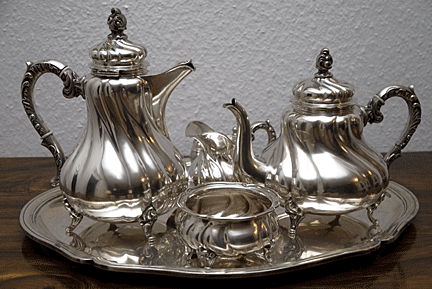
Thereís nothing as disheartening as having beautiful antique silver
develop a mottled brown or black blanket of tarnish, obscuring the
luster. The discoloration that appears on the surface of tarnished
silver isnít a flaw of silver itself: pure silver would never
tarnish. On the other hand, no piece is pure silver as it would be
too malleable to use.
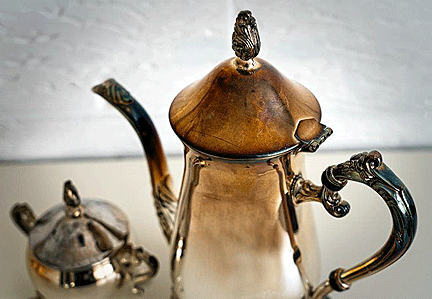 Silver
is technically an alloy, made by mixing pure silver with copper to
stabilize it. To indicate how much silver is in a piece of sterling
silver, itís stamped with the mark ď.925,Ē which indicates that the
piece meets the sterling standard of being 92.5% silver. The
remaining 7.5% comprised of other metals. Silver
is technically an alloy, made by mixing pure silver with copper to
stabilize it. To indicate how much silver is in a piece of sterling
silver, itís stamped with the mark ď.925,Ē which indicates that the
piece meets the sterling standard of being 92.5% silver. The
remaining 7.5% comprised of other metals.
This small percentage of other metals causes the tarnish to appear
as a chemical reaction with the elements of the environment in which
the silver is stored. One of these elements is humidity. The more
moisture in the air, the quicker tarnish will form. Another is
contact with chemicals in the environment, from a sulfurous dish of
Brussels sprouts to home products like hairspray or lotion. .
While these elements can be somewhat controlled, inevitably
tarnished antique silver will need to be cleaned. Though tarnish may
be unsightly, it doesnít damage silver, and using the appropriate
cleaning techniques can help ensure that it keep sparkling.
How to Clean Tarnished Silver
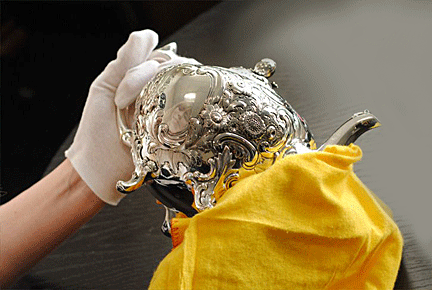 When
preparing to clean antique silver, the main goal is to preserve the
silver surface of antique sterling silver pieces. Unfortunately,
store-bought silver cleaners contain chemical components which can
potentially damage antique pieces. Itís also unwise to use a hard
bristle brush to remove surface tarnish or other materials, as it
may scratching the surface. When
preparing to clean antique silver, the main goal is to preserve the
silver surface of antique sterling silver pieces. Unfortunately,
store-bought silver cleaners contain chemical components which can
potentially damage antique pieces. Itís also unwise to use a hard
bristle brush to remove surface tarnish or other materials, as it
may scratching the surface.
Before beginning to clean tarnished silver, itís a good idea to
cover the work surface to protect the piece. Itís also best to wear
a pair of cotton gloves to limit the amount of oils and other
residue which could eat into the pieceís surface.
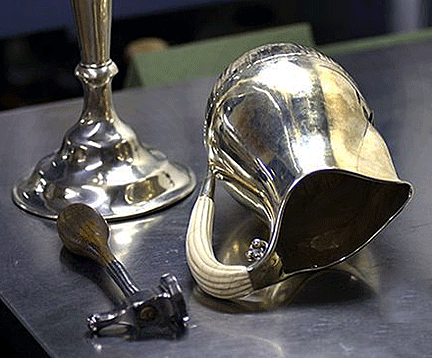 The
combination of a silver cleaning cloth and a solution of warm water
combined with a mild detergent should take care of light tarnish.
After a piece has been gone over, it should be dried thoroughly
before storing it. The
combination of a silver cleaning cloth and a solution of warm water
combined with a mild detergent should take care of light tarnish.
After a piece has been gone over, it should be dried thoroughly
before storing it.
Finally, for really stubborn tarnish, mixing a tablespoon each of
baking soda and salt, then adding it to a half cup of white vinegar
and a cup of boiling water. If the piece it large, this mixture can
be doubled or tripled. This solution then gets poured into an
aluminum foil-lined pan into which the silver piece is submerged.
The result is an almost immediate dissolution of the tarnish due to
an electrochemical reaction.
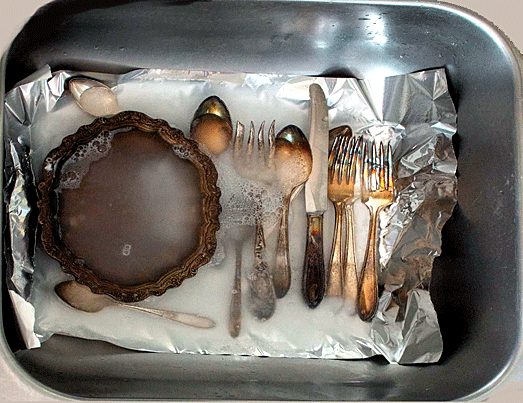
After cleaning the tarnish off antique silver, it should periodically be
dusted with a soft cloth and a soft bristle brush.
<
Back to Caring for Your Collections
Archives
Next Article > |
